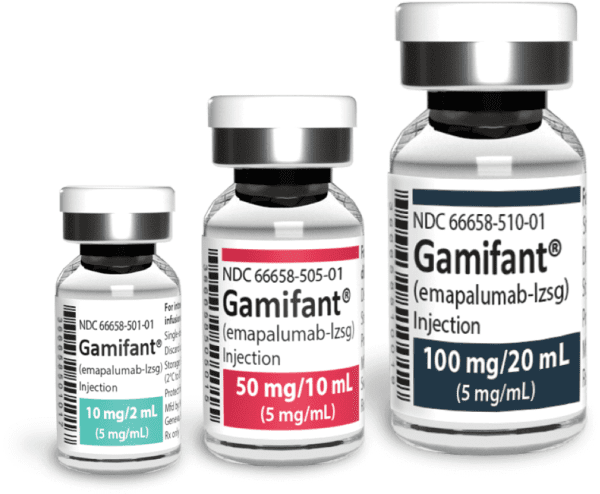Gamifant: Package Insert / Prescribing Info
Package insert / product label
Generic name: emapalumab-lzsg
Dosage form: injection
Drug class: Selective immunosuppressants
J Code (medical billing code): J9210 (1 mg, injection)
Medically reviewed by Drugs.com. Last updated on Jul 16, 2025.
On This Page
- Indications and Usage
- Dosage and Administration
- Dosage Forms and Strengths
- Contraindications
- Warnings and Precautions
- Adverse Reactions/Side Effects
- Drug Interactions
- Use In Specific Populations
- Overdosage
- Description
- Clinical Pharmacology
- Nonclinical Toxicology
- Clinical Studies
- How Supplied/Storage and Handling
- Patient Counseling Information
- Medication Guide
Highlights of Prescribing Information
GAMIFANT® (emapalumab-lzsg) injection, for intravenous use
Initial U.S. Approval: 2018
Recent Major Changes
Indications and Usage for Gamifant
GAMIFANT is an interferon gamma (IFNγ) neutralizing antibody indicated for the treatment of:
- adult and pediatric (newborn and older) patients with primary hemophagocytic lymphohistiocytosis (HLH) with refractory, recurrent or progressive disease or intolerance with conventional HLH therapy. (1)
- adult and pediatric (newborn and older) patients with HLH/macrophage activation syndrome (MAS) in known or suspected Still’s disease, including systemic Juvenile Idiopathic Arthritis (sJIA), with an inadequate response or intolerance to glucocorticoids, or with recurrent MAS. (1)
Gamifant Dosage and Administration
For intravenous infusion only:
- Primary HLH recommended starting dosage: 1 mg/kg as an intravenous infusion over 1 hour twice per week. (2.1)
- HLH/MAS in Still’s disease recommended starting dose: 6 mg/kg, followed by 3 mg/kg every 3 days for 5 doses, then 3 mg/kg twice per week. Given as an intravenous infusion over 1 hour. (2.2)
- For both indications, the dose may be titrated up to a maximum of 10 mg/kg. (2.5, 2.6)
Dosage Forms and Strengths
Injection:
• 10 mg/2 mL (5 mg/mL) solution in a single-dose vial (3)
• 50 mg/10 mL (5 mg/mL) solution in a single-dose vial (3)
• 100 mg/20 mL (5 mg/mL) solution in a single-dose vial (3)
• 50 mg/2 mL (25 mg/mL) solution in a single-dose vial (3)
• 100 mg/4 mL (25 mg/mL) solution in a single-dose vial (3)
• 250 mg/10 mL (25 mg/mL) solution in a single-dose vial (3)
• 500 mg/20 mL (25 mg/mL) solution in a single-dose vial (3)
Contraindications
- None. (4)
Warnings and Precautions
- Infections: Monitor patients for signs and symptoms and treat promptly. Test for latent tuberculosis. Consider administering prophylactic treatment against Herpes Zoster, Pneumocystis jirovecii and fungal infections. (5.1)
- Live Vaccines: Do not administer live or live attenuated vaccines to patients receiving GAMIFANT. (5.2)
- Infusion-Related Reactions: Monitor patients for infusion-related reactions. Interrupt infusion for severe infusion reactions and institute appropriate medical management. (5.3)
Adverse Reactions/Side Effects
In patients with primary HLH, the most common adverse reactions (≥ 20%) were: infections, hypertension, infusion-related reactions, and pyrexia. (6.1)
In patients with HLH/MAS in Still’s disease, the most common adverse reactions (≥20%) were:viral infections, including cytomegalovirus infection or reactivation, and rash. (6.1)
To report SUSPECTED ADVERSE REACTIONS, contact 1-866-773-5274 or FDA at 1-800-FDA-1088 or www.fda.gov/medwatch.
See 17 for PATIENT COUNSELING INFORMATION and Medication Guide.
Revised: 6/2025
Full Prescribing Information
1. Indications and Usage for Gamifant
GAMIFANT is indicated for the treatment of:
- adult and pediatric (newborn and older) patients with primary hemophagocytic lymphohistiocytosis (HLH) with refractory, recurrent or progressive disease or intolerance with conventional HLH therapy.
- adult and pediatric (newborn and older) patients with HLH/macrophage activation syndrome (MAS) in known or suspected Still’s disease, including systemic Juvenile Idiopathic Arthritis (sJIA), with an inadequate response or intolerance to glucocorticoids, or with recurrent MAS.
2. Gamifant Dosage and Administration
2.1 Recommended Dosage for Primary Hemophagocytic Lymphohistiocytosis
The recommended starting dose of GAMIFANT is 1 mg/kg given as a central or peripheral intravenous infusion over 1 hour twice per week (every three to four days). Doses subsequent to the initial dose may be increased based on clinical and laboratory criteria [see Dosage and Administration (2.5)].
Administer GAMIFANT until hematopoietic stem cell transplantation (HSCT) is performed or unacceptable toxicity. Discontinue GAMIFANT when a patient no longer requires therapy for the treatment of HLH.
2.2 Recommended Dosage for Hemophagocytic Lymphohistiocytosis/Macrophage Activation Syndrome
GAMIFANT is administered as a central or peripheral intravenous infusion over 1 hour according to the dosage schedule in Table 1. Doses may be increased based on clinical and laboratory criteria [see Dosage and Administration (2.6)]. Discontinue GAMIFANT when a patient no longer requires therapy for the treatment of HLH/MAS.
Table 1. GAMIFANT Dosage in Patients with HLH/MAS
|
Treatment Day |
GAMIFANT Dosage |
|
Day 1 |
6 mg/kg |
|
Days 4 to 16 |
3 mg/kg every 3 days for 5 doses |
|
From Day 19 onward |
3 mg/kg twice per week (i.e., every 3 to 4 days) |
2.3 Monitoring to Assess Safety
Before Initiating GAMIFANT Treatment
Conduct testing for latent tuberculosis infections using the purified protein derivative (PPD) or IFNγ release assay and evaluate patients for tuberculosis risk factors prior to initiating GAMIFANT. Administer tuberculosis prophylaxis to patients at risk for tuberculosis, or known to have a positive PPD test result, or positive IFNγ release assay.
During GAMIFANT Treatment
Monitor for Herpes Zoster infection, adenovirus, EBV and CMV as clinically indicated.
2.4 Prophylaxis and Concomitant Medication Information
Prophylaxis
Consider prophylaxis for Herpes Zoster, Pneumocystis jirovecii, and for fungal infections prior to GAMIFANT administration.
Concomitant Medications
For primary HLH patients who are not receiving baseline dexamethasone treatment, begin dexamethasone at a daily dose of at least 5 mg/m2 to 10 mg/m2 the day before GAMIFANT treatment begins. For patients who were receiving baseline dexamethasone, they may continue their regular dose provided the dose is at least 5 mg/m2. Dexamethasone can be tapered according to the judgment of the treating physician [see Clinical Studies (14)].
2.5 Dose Modification Based on Response for Primary Hemophagocytic Lymphohistiocytosis
The GAMIFANT dose may be titrated up if disease response is unsatisfactory (see Table 2) [see Clinical Pharmacology (12.3)] . After the patient's clinical condition is stabilized, decrease the dose to the previous level to maintain clinical response.
| Treatment Day | GAMIFANT Dose | Criteria for Dose Increase |
| Day 1 | Starting Dose of 1 mg/kg | N/A |
| From Day 4 onwards | Increase to 3 mg/kg | Unsatisfactory improvement in clinical condition, as assessed by a healthcare provider AND at least one of the following:
|
| From Day 7 onwards | Increase to 6 mg/kg | |
| From Day 10 onwards | Increase to 10 mg/kg | Assessment by a healthcare provider that based on initial signs of response, a further increase in GAMIFANT dose can be of benefit |
2.6 Dose Modification Based on Response for Hemophagocytic Lymphohistiocytosis/Macrophage Activation Syndrome
Table 3: Dosage Adjustment Criteria
|
Treatment Day |
GAMIFANT Dose |
Dose Adjustments |
|
Day 1 |
Initial dose of 6 mg/kg |
If unsatisfactory improvement in clinical condition, as assessed by a healthcare provider, the dose of GAMIFANT may be increased to:
AND the frequency may be increased to:
After the patient’s clinical condition has improved, consider decreasing the dose to the previous level and assess whether clinical response is maintained. If the clinical condition is not stabilized while receiving the maximum dosage, consider discontinuing GAMIFANT. |
|
Days 4 to 16 |
3 mg/kg every 3 days for 5 doses |
|
|
From Day 19 onwards |
3 mg/kg twice per week (i.e., every 3 to 4 days) |
2.7 Instructions for Preparation and Administration
Preparation
GAMIFANT vials are for single dose only.
Do not mix GAMIFANT 5 mg/mL and 25 mg/mL vials together.
Prepare the solution for infusion as follows:
- Calculate the dose (mg/kg), total volume (mL) of GAMIFANT required and the number of GAMIFANT vials needed based on patient actual body weight [see Dosage and Administration (2.1)].
- Parenteral drug products should be inspected visually for particulate matter and discoloration prior to administration, whenever solution and container permit. GAMIFANT is a clear to slightly opalescent, colorless to slightly yellow liquid. Do not administer if discolored or foreign particulate matter is present.
- Withdraw the necessary amount of GAMIFANT solution and dilute with 0.9% Sodium Chloride Injection, USP.
- For GAMIFANT 5 mg/mL vials:
- Dilute to a maximum concentration of 2.5 mg/mL. Do not dilute product to less than 0.25 mg/mL.
- The diluted solution can be placed in either a syringe or an infusion bag, depending on the volume needed.
- When using a syringe, use a gamma irradiated or ethylene oxide sterilized latex-free, polyvinyl chloride (PVC)-free syringe.
- When using an infusion bag, use a non-PVC polyolefin infusion bag.
- For GAMIFANT 25 mg/mL vials:
- Dilute to a maximum concentration of 12.5 mg/mL. Do not dilute product to less than 1.25 mg/mL.
- Use a non-PVC polyolefin infusion bag made from either polyethylene or ethylene/propylene copolymer.
- For GAMIFANT 5 mg/mL vials:
- Discard any unused portion left in the vial(s).
Administration
- Administer GAMIFANT diluted solution intravenously over 1 hour through a central or peripheral intravenous line containing a sterile, non-pyrogenic, low-protein binding 0.2 micron in-line filter.
- Do not infuse GAMIFANT concomitantly with other agents and do not add any other product to the infusion bag or syringe.
- Do not store any unused portion of the infusion solution for reuse. Any unused product or waste material should be disposed of in accordance with local requirements.
Storage of Diluted Solution
This product does not contain a preservative.
If not administered immediately:
- Store the diluted solution of GAMIFANT under refrigeration at 2°C to 8°C (36°F to 46°F) for no more than 4 hours from the time of dilution.
- If refrigerated, allow the diluted solution to come to room temperature prior to administration.
- Do not freeze. Do not shake.
3. Dosage Forms and Strengths
GAMIFANT is a clear to slightly opalescent, colorless to slightly yellow preservative-free solution available as:
Injection:
• 10 mg/2 mL (5 mg/mL) in a single-dose vial
• 50 mg/10 mL (5 mg/mL) in a single-dose vial
• 100 mg/20 mL (5 mg/mL) in a single-dose vial
• 50 mg/2 mL (25 mg/mL) in a single-dose vial
• 100 mg/4 mL (25 mg/mL) in a single-dose vial
• 250 mg/10 mL (25 mg/mL) in a single-dose vial
• 500 mg/20 mL (25 mg/mL) in a single-dose vial
5. Warnings and Precautions
5.1 Infections
GAMIFANT may increase the risk of fatal and serious infections to include specific pathogens favored by IFNγ neutralization, including mycobacteria, Herpes Zoster virus, and Histoplasma Capsulatum.
Do not administer GAMIFANT in patients with infections caused by these pathogens until appropriate treatment has been initiated.
In patients with primary HLH receiving GAMIFANT in clinical trials, serious infections such as sepsis, pneumonia, bacteremia, disseminated histoplasmosis, necrotizing fasciitis, viral infections, and perforated appendicitis were observed in 32% of patients. The reported infections were viral (41%), bacterial (35%), fungal (9%), and the pathogen was not identified in 15% of cases.
In patients with HLH/MAS in Still’s disease receiving GAMIFANT in clinical trials, serious infections such as pneumonia, cytomegalovirus infection, cytomegalovirus infection reactivation, and sepsis were observed in 13% of patients. The reported infections were viral (44%), bacterial (13%), fungal (3%) and the pathogen was not identified in (13%) of patients.
Evaluate patients for tuberculosis risk factors and test for latent infection (PPD testing, PCR, or IFNγ release assay) prior to initiating GAMIFANT. Administer tuberculosis prophylaxis to patients at risk for tuberculosis or known to have a positive purified protein derivative (PPD) test result [see Dosage and Administration (2.2)].
Consider prophylaxis for Herpes Zoster, Pneumocystis jirovecii, and fungal infection to mitigate the risk to patients while receiving GAMIFANT [see Dosage and Administration (2.3)]. Employ surveillance testing during treatment with GAMIFANT.
Closely monitor patients receiving GAMIFANT for signs or symptoms of infection, promptly initiate a complete diagnostic workup appropriate for an immunocompromised patient, and initiate appropriate antimicrobial therapy.
5.2 Increased Risk of Infection with Use of Live Vaccines
Do not administer live or live attenuated vaccines to patients receiving GAMIFANT and for at least 4 weeks after the last dose of GAMIFANT. The safety of immunization with live vaccines during or following GAMIFANT therapy has not been studied.
5.3 Infusion-Related Reactions
Infusion-related reactions in patients with primary HLH, including drug eruption, pyrexia, rash, erythema, and hyperhidrosis, were reported with GAMIFANT treatment in 27% of patients. In one-third of these patients, the infusion-related reaction occurred during the first infusion.
Infusion-related reactions in patients with HLH/MAS in Still’s disease, including pyrexia, headache, paresthesia, bone pain, pruritic rash, and peripheral coldness, were reported with GAMIFANT treatment in 13% of patients. Infusion related reactions were reported as mild in 8% of patients and as moderate in 5% of patients.
Monitor patients for infusion-related reactions which can be severe. Interrupt the infusion for infusion reactions and institute appropriate medical management prior to continuing infusion at a slower rate.
6. Adverse Reactions/Side Effects
The following adverse reactions are described elsewhere in the labeling:
- Infections [see Warnings and Precautions (5.1)]
- Increased Risk of Infection with Use of Live Vaccines [see Warnings and Precautions (5.2)]
- Infusion-Related Reactions [see Warnings and Precautions (5.3)]
6.1 Clinical Trial Experience
Because clinical trials are conducted under widely varying conditions, adverse reaction rates observed in the clinical trials of a drug cannot be directly compared to rates in the clinical trials of another drug and may not reflect the rates observed in practice.
Primary HLH
The safety data described in this section reflect exposure to GAMIFANT in which 34 patients with untreated primary HLH and previously treated patients with primary HLH (NCT01818492) received GAMIFANT at a starting dose of 1 mg/kg every 3 days with dose increases up to 10 mg/kg [see Dosage and Administration (2.1) and Clinical Studies (14)]. The median duration of treatment with GAMIFANT was 59 days (range: 4 to 245 days) and the median cumulative dose was 25 mg/kg (range: 4 to 254 mg/kg).
The median age of study population was 1 year (range: 0.1 to 13 years), 53% were female, and 65% were Caucasian.
Serious adverse reactions were reported in 53% of patients. The most common serious adverse reactions (≥3%) included infections, gastrointestinal hemorrhage, and multiple organ dysfunction. Fatal adverse reactions occurred in two (6%) of patients and included septic shock and gastrointestinal hemorrhage.
Disseminated histoplasmosis led to drug discontinuation in one patient. The most commonly reported adverse reactions (≥20%) were infections, hypertension, infusion-related reactions, and pyrexia. Adverse reactions reported in ≥10% of patients during treatment with GAMIFANT are presented in Table 4.
Table 4: Adverse Reactions Reported in 10% of Patients with Primary HLH
|
Adverse Reactions |
GAMIFANT (%) (N = 34) |
|
Infectionsa |
56 |
|
Hypertensionb |
41 |
|
Infusion-related reactionsc |
27 |
|
Pyrexia |
24 |
|
Hypokalemia |
15 |
|
Constipation |
15 |
|
Rash |
12 |
|
Abdominal pain |
12 |
|
Cytomegalovirus infection |
12 |
|
Diarrhea |
12 |
|
Lymphocytosis |
12 |
|
Cough |
12 |
|
Irritability |
12 |
|
Tachycardia |
12 |
|
Tachypnea |
12 |
aIncludes viral, bacterial, fungal, and infections in which no pathogen was identified
bIncludes secondary hypertension
cIncludes events of drug eruption, pyrexia, rash, erythema, and hyperhidrosis
Additional selected adverse reactions (all grades) that were reported in less than 10% of patients treated with GAMIFANT included: vomiting, acute kidney injury, asthenia, bradycardia, dyspnea, gastro-intestinal hemorrhage, epistaxis, and peripheral edema.
HLH/MAS
The safety of GAMIFANT was evaluated in two open-label clinical studies in patients with HLH/MAS in Stills disease, including sJIA [see Clinical Studies (14.2)].
The pooled safety data from these two studies included 39 patients who received an initial dose of 6 mg/kg followed by 3 mg/kg every 3 days until Day 16, and then twice weekly thereafter. The median duration of treatment with GAMIFANT was 29 days (range: 7 to 220 days) and the median cumulative dose was 33 mg/kg (range: 12 to 175 mg/kg).
Serious adverse reactions were reported in 12 patients (31%), with the most common serious adverse reaction being pneumonia (5%). Fatal adverse reactions occurred in two patients (5%) and included multiple organ dysfunction and circulatory shock.
Pneumonia led to drug discontinuation in one patient (3%). The most common adverse reactions (≥20%) were viral infections, including cytomegalovirus infection or reactivation, and rash. Adverse reactions reported in ≥ 10% of patients in the pooled safety analysis up to Week 8 during treatment with GAMIFANT are presented in Table 5.
Table 5: Adverse Reactions Reported in ≥10% of Patients with HLH/MAS in Stills disease
|
Adverse Reactions |
GAMIFANT (%) (N = 39) |
|
Viral infectiona Cytomegalovirus infection or reactivation |
44 36 |
|
Rashb |
21 |
|
Anemiac |
18 |
|
Leukopeniad |
15 |
|
Thrombosis |
15 |
|
Bacterial infection |
13 |
|
Headache |
13 |
|
Hyperglycemia |
13 |
|
Infusion-related reactionse |
13 |
|
Abdominal pain |
10 |
|
Hypertension |
10 |
|
Pyrexia |
10 |
|
Thrombocytopenia |
10 |
aIncludes: Cytomegalovirus infection reactivation, Cytomegalovirus infection, Adenovirus test positive, Cytomegalovirus test positive, BK polyomavirus test positive, Respirovirus test positive, Parainfluenzae virus infection, COVID-19, Rhinovirus infection, gastroenteritis Rotavirus, Adenovirus infection, Human herpesvirus 6 infection reactivation, Adenovirus reactivation
bIncludes: rash maculo-papular, rash erythematous, rash pruritic, urticaria
cIncludes: anemia macrocytic, and hypochromic anemia
dIncludes: granulocytopenia, neutropenia
eInfusion-related reactions were defined as any event reported to have occurred within 24 hours after the start of infusion and assessed as related to study treatment
Related/similar drugs
7. Drug Interactions
7.1 Effect of GAMIFANT on Cytochrome P450 Substrates
The formation of CYP450 enzymes may be suppressed by increased levels of cytokines (such as IFNγ) during chronic inflammation. By neutralizing IFNγ, use of GAMIFANT may normalize CYP450 activities which may reduce the efficacy of drugs that are CYP450 substrates due to increased metabolism.
Upon initiation or discontinuation of concomitant GAMIFANT, monitor for reduced efficacy and adjust dosage of CYP450 substrate drugs as appropriate.
8. Use In Specific Populations
8.1 Pregnancy
Risk Summary
There are no available data on GAMIFANT use in pregnant women to inform a drug-associated risk of adverse developmental outcomes. In an animal reproduction study, a murine surrogate anti-mouse IFNγ antibody administered to pregnant mice throughout gestation crossed the placental barrier, and no fetal harm was observed (see Data) .
The estimated background risk of major birth defects and miscarriage for the indicated population is unknown. All pregnancies have a background risk of birth defect, loss, or other adverse outcomes. In the U.S. general population, the estimated background risk of major birth defects and miscarriage in clinically recognized pregnancies is 2 to 4% and 15 to 20%, respectively.
Data
Animal Data
In a mouse embryo-fetal development study, a murine surrogate anti-mouse IFNγ antibody was administered every 3-4 days throughout organogenesis and late gestation at doses of 0, 30, 75 or 150 mg/kg/occasion. The surrogate antibody was detected in the plasma of all treated pregnant mice and their corresponding fetuses. No maternal toxicity occurred and there was no evidence of teratogenicity or effects on embryo-fetal survival or growth.
8.2 Lactation
Risk Summary
There is no information regarding the presence of emapalumab-lzsg in human milk, the effects on the breastfed child, or the effects on milk production. Published data suggest that only limited amounts of therapeutic antibodies are found in breast milk and they do not enter the neonatal and infant circulations in substantial amounts.
The developmental and health benefits of breastfeeding should be considered along with the mother's clinical need for GAMIFANT and any potential adverse effects on the breastfed child from GAMIFANT or from the underlying maternal condition.
8.4 Pediatric Use
Safety and effectiveness of GAMIFANT have been established in pediatric patients, newborn and older, with primary HLH that is reactivated or refractory to conventional therapies and with HLH/MAS in Still’s Disease (including sJIA) with an inadequate response to glucocorticoids [see Clinical Studies (14)]. Use of GAMIFANT is supported by 3 single-arm trials which included 57 pediatric patients: 27 with primary HLH and 30 with HLH/MAS in Still’s disease. These studies included pediatric patients in the following age groups: 5 patients newborn to 6 months, 13 patients 6 months to 2 years, 27 patients from 2 years to <12 years, and 12 patients from 12 years to <17 years.
8.5 Geriatric Use
Clinical studies of GAMIFANT did not include sufficient numbers of subjects aged 65 and over to determine whether they respond differently from younger subjects. Other reported clinical experience has not identified differences in responses between the elderly and younger patients.
10. Overdosage
Consider contacting the Poison Help line (1-800-222-1222) or a medical toxicologist for additional overdose management recommendations.
11. Gamifant Description
Emapalumab-lzsg is an interferon gamma (IFNγ) neutralizing antibody. Emapalumab-lzsg is produced in Chinese Hamster Ovary cells by recombinant DNA technology. Emapalumab-lzsg is an IgG1 immunoglobulin with a molecular weight of approximately 148 kDa.
GAMIFANT (emapalumab-lzsg) injection for intravenous use is a sterile, preservative-free, clear to slightly opalescent, colorless to slightly yellow solution provided in single-dose vials that require dilution prior to intravenous infusion.
GAMIFANT 5 mg/mL (2 mL, 10 mL and 20 mL)
Each vial contains 10 mg/2 mL, 50 mg/10 mL, or 100 mg/20 mL emapalumab-lzsg at a concentration of 5 mg/mL. Each mL also contains the following inactive ingredients: L-Histidine (1.55 mg), L-Histidine monohydrochloride, monohydrate (3.14 mg), Polysorbate 80 (0.05 mg), sodium chloride (7.30 mg), and Water for Injection, USP.
GAMIFANT 25 mg/mL (2 mL, 4 mL, 10 mL and 20 mL)
Each vial contains 50 mg/2 mL, 100 mg/4 mL, 250 mg/10 mL or 500 mg/20 mL emapalumab- lzsg at a concentration of 25 mg/mL. Each mL also contains the following inactive ingredients: L-Histidine (1.55 mg), L-Histidine monohydrochloride, monohydrate (3.14 mg), Polysorbate 80 (0.05 mg), sodium chloride (7.30 mg), and Water for Injection, USP.
12. Gamifant - Clinical Pharmacology
12.1 Mechanism of Action
Emapalumab-lzsg is a monoclonal antibody that binds to and neutralizes interferon gamma (IFNγ). Nonclinical data suggest that IFNγ plays a pivotal role in the pathogenesis of HLH by being hypersecreted.
12.2 Pharmacodynamics
12.3 Pharmacokinetics
The pharmacokinetics of emapalumab-lzsg were evaluated in healthy adult subjects and in patients with HLH.
Following a 1 mg/kg emapalumab-lzsg dose, median steady state peak concentration was 44 mcg/mL, which was 2.9 times higher than after the first dose. The median steady state trough concentration was 25 mcg/mL, which was 4.3 times higher than after the first dose.
Emapalumab-lzsg AUC increases slightly more than proportionally between 1 and 3 mg/kg doses, and less than proportionally at 3, 6, and 10 mg/kg doses.
Emapalumab-lzsg exhibits target-mediated-like clearance dependent on IFNγ production, which can vary between and within patients as a function of time and can affect the recommended dosage [see Dosage and Administration (2.2)] . Emapalumab-lzsg steady state is achieved by the 7th infusion when the IFNγ production is moderate. At high IFNγ production, steady-state is reached earlier due to a shorter half-life.
Distribution
The central and peripheral volumes of distribution in a subject with body weight of 70 kg are 2.8 and 4.4 L, respectively.
Elimination
Emapalumab-lzsg elimination half-life is approximately 22 days in healthy subjects and ranged from 2.5 to 18.9 days in HLH patients.
In patients with HLH, the elimination half-life of emapalumab-lzsg was significantly influenced by the amount of IFNγ within the patient, demonstrating a target mediated clearance-like mechanism. The elimination half-life of emapalumab-lzsg is reduced as the concentration of IFNγ increases.
Emapalumab-lzsg clearance is approximately 0.007 L/h in healthy subjects.
Metabolism
The metabolic pathway of emapalumab-lzsg has not been characterized. Like other protein therapeutics, GAMIFANT is expected to be degraded into small peptides and amino acids via catabolic pathways.
Specific Populations
Body weight (3 to 80 kg) was a significant covariate of emapalumab-lzsg pharmacokinetics, supporting body weight-based dosing.
No clinically significant differences in the pharmacokinetics of emapalumab-lzsg were observed based on age (0.02 to 64 year), sex (53% Females), race (71.4% Caucasian, 12.2% Asian and 8.2% Black), renal impairment including dialysis, or hepatic impairment (mild, moderate, and severe).
12.4 Immunogenicity
As with all therapeutic proteins, there is potential for immunogenicity. The detection of antibody formation is highly dependent on the sensitivity and specificity of the assay. Additionally, the observed incidence of antibody (including neutralizing antibody) positivity in an assay may be influenced by several factors, including assay methodology, sample handling, timing of sample collection, concomitant medications, and underlying disease. For these reasons, comparison of the incidence of antibodies in the studies described below with the incidence of antibodies in other studies or to other emapalumab products may be misleading.
The immunogenicity of emapalumab-lzsg has been evaluated using an electrochemiluminescence-based immunoassay (ECLIA).Treatment-emergent anti-drug antibodies (ADAs) were detected in 1/33 (3%) of patients in the primary HLH clinical trial. The ADAs in this patient were found to have neutralizing ability. Treatment-emergent ADAs were detected in 5/35 patients (14%) in the two HLH/MAS clinical trials. None of the ADAs in these 5 patients were found to have neutralizing ability. No evidence of an altered pharmacokinetic, safety or efficacy profile was identified in primary HLH or HLH/MAS patients who developed antibodies to emapalumab-lzsg.
13. Nonclinical Toxicology
13.1 Carcinogenesis, Mutagenesis, Impairment of Fertility
No carcinogenicity or genotoxicity studies have been conducted with emapalumab-lzsg.
No studies have been conducted to evaluate the effects of emapalumab-lzsg on fertility; however, no adverse effects on male or female reproductive organs were observed in the 8- or 13-week repeat-dose toxicity studies in cynomolgus monkeys.
14. Clinical Studies
14.1 Primary Hemophagocytic Lymphohistiocytosis
The efficacy of GAMIFANT was evaluated in a multicenter, open-label, single-arm trial NI-0501-04 (NCT01818492) in 27 pediatric patients with suspected or confirmed primary Hemophagocytic lymphohistiocytosis (HLH) with either refractory, recurrent, or progressive disease during conventional HLH therapy or who were intolerant of conventional HLH therapy.
Patients were required to fulfill the following criteria for enrollment: primary HLH based on a molecular diagnosis or family history consistent with primary HLH or five out of the 8 criteria fulfilled: fever, splenomegaly, cytopenias affecting 2 of 3 lineages in the peripheral blood (hemoglobin < 9, platelets < 100 x 109/L, neutrophils < 1 x 109/L), hypertriglyceridemia (fasting triglycerides > 3 mmol/L or ≥265 mg/dL) and/or hypofibrinogenemia (≤1.5 g/L), hemophagocytosis in bone marrow, spleen, or lymph nodes with no evidence of malignancy, low or absent NK-cell activity, ferritin ≥500 mcg/L, soluble CD25 ≥2400 U/mL. Patients had to have evidence of active disease as assessed by the treating physician. Patients had to fulfill one of the following criteria as assessed by the treating physician: having not responded or not achieved a satisfactory response or not maintained a satisfactory response to conventional HLH therapy, or intolerance to conventional HLH treatments. Patients with active infections caused by specific pathogens favored by IFNγ neutralization were excluded from the trial (e.g., mycobacteria and Histoplasma Capsulatum). Patients received prophylaxis for Herpes Zoster, Pneumocystis jirovecii, and fungal infections.
Twenty-seven patients enrolled and received treatment in the study and twenty patients (74%) completed the study. Seven patients (26%) were prematurely withdrawn. Twenty-two patients (81%) enrolled onto the open-label extension study which monitored patients for up to 1 year after HSCT or after the last GAMIFANT infusion (NI-0501-05; NCT02069899).
The study treatment duration was up to 8 weeks after which patients could continue treatment on the extension study. All patients received an initial starting dose of GAMIFANT of 1 mg/kg every 3 days. Subsequent doses could be increased to a maximum of 10 mg/kg based on clinical and laboratory parameters interpreted as unsatisfactory response. Forty-four percent of patients remained at a dose of 1 mg/kg, 30% of patients increased to 3-4 mg/kg and 26% of patients increased to 6-10 mg/kg. The median time to dose increase was 27 days (range: 3-31 days) with 22% of patients requiring a dose increase in the first week of treatment.
All patients received dexamethasone as background HLH treatment with doses between 5 to 10 mg/m2/day. Cyclosporine A was continued if administered prior to screening. Patients receiving methotrexate and glucocorticoids administered intrathecally at baseline could continue these treatments.
In Study NI-0501-04, the median patient age was 1 year (0.2 to 13). Fifty-nine percent of the patients were female, 63% were Caucasian, 11% were Asian, and 11% were Black.
A genetic mutation known to cause HLH was present in 82% of patients. The most frequent causative mutations were FHL3-UNC13D (MUNC 13-4) (26%), FHL2-PRF1 (19%), and Griscelli Syndrome type 2 (19%).
The HLH mutations in the population enrolled are described in Table 6
| GAMIFANT
(N=27) |
|
| HLH Genetic Confirmation | 22 (82) |
| FHL3 UNC13D | 7 (26) |
| FHL2 PRF1 | 5 (19) |
| Griscelli Syndrome type 2 (RAB27A) | 5 (19) |
| FHL5 STXBP2 (UNC18B) | 2 (7.4) |
| FHL4 STX11 | 1 (3.7) |
| X-linked Lymphoproliferative Disorder 1 | 1 (3.7) |
| X-linked Lymphoproliferative Disorder 2 | 1 (3.7) |
All patients received previous HLH treatments. Patients received a median of 3 prior agents before enrollment into the trial. Prior regimens included combinations of the following agents: dexamethasone, etoposide, cyclosporine A, and anti-thymocyte globulin.
At baseline entry into the study, 78% of patients had elevated ferritin levels, thrombocytopenia (70% with platelet count of < 100 x 109cells/L), hypertriglyceridemia (67%) with triglyceride level >3 mmol/L. Central nervous system findings were present in 37% of patients. Forty-one percent of patients had active infections not due to specific pathogens favored by IFNγ neutralization at the time of GAMIFANT initiation.
The efficacy of GAMIFANT was based upon overall response rate (ORR) at the end of treatment, defined as achievement of either a complete or partial response or HLH improvement. ORR was evaluated using an algorithm that included the following objective clinical and laboratory parameters: fever, splenomegaly, central nervous system symptoms, complete blood count, fibrinogen and/or D-dimer, ferritin, and soluble CD25 (also referred to as soluble interleukin-2 receptor) levels. Complete response was defined as normalization of all HLH abnormalities (i.e., no fever, no splenomegaly, neutrophils >1x109/L, platelets >100x109/L, ferritin <2,000 µg/L, fibrinogen >1.50 g/L, D-dimer <500 µg/L, normal CNS symptoms, no worsening of sCD25 >2-fold baseline). Partial response was defined as normalization of ≥3 HLH abnormalities. HLH improvement was defined as ≥3 HLH abnormalities improved by at least 50% from baseline.
| GAMIFANT
(N=27) |
|
| Overall Response Rate | |
| N (%) | 17 (63) |
| (95% CI) | (0.42, 0.81) |
| p-value† | 0.013 |
| Overall Response by Category | |
| Complete response, n (%) | 7 (26) |
| Partial response | 8 (30) |
| HLH improvement | 2 (7.4) |
†p-value based on Exact Binomial Test at a one-sided significance level of 2.5% comparing proportion of patients with overall response to hypothesized null hypothesis of 40%.
CI = confidence interval
The median duration of first response, defined as time from achievement of first response to loss of first response, is not reached (range: 4-56+ days). Seventy percent (19/27) of patients proceeded to HSCT.
14.2 Hemophagocytic Lymphohistiocytosis/Macrophage Activation Syndrome in Still’s disease
The efficacy of GAMIFANT was evaluated in two open-label, single arm, multicenter studies which enrolled a total of 39 patients with hemophagocytic lymphohistiocytosis (HLH)/macrophage activation syndrome (MAS) in Still’s disease, including systemic Juvenile Idiopathic Arthritis (sJIA), with an inadequate response to high-dose glucocorticoid treatment.
In each study, patients were required to fulfill the following criteria for enrollment: confirmed or suspected diagnosis of sJIA or AOSD; a diagnosis of active MAS with ferritin >684 ng/mL and any 2 of these 4 laboratory criteria: platelet count ≤181×109/L, AST >48 U/L, triglycerides >156 mg/dL, or fibrinogen levels ≤360 mg/dL; an inadequate response to high-dose IV glucocorticoids. Patients with active infections caused by specific pathogens favored by IFNγ neutralization were excluded from the trial (e.g., mycobacteria and Histoplasma Capsulatum).
In each study, GAMIFANT was administered at an initial dose of 6 mg/kg, followed by at least 3 mg/kg every 3 days until Day 16, and then twice weekly thereafter. Glucocorticoids and anakinra (<4 mg/kg/d) could be co-administered for the treatment of Still’s disease.
Pooled Data
The pooled analysis includes all patients from Study NI-0501-06 (NCT03311854) and Study NI-0501-14 (NCT05001737). These two studies enrolled 39 patients who received GAMIFANT, and 37 patients completed the studies (95%). The majority of patients were female (80%) and the median age was 12.0 years (range: 0.9 to 64 years). The racial distribution was White (74%), Asian (10%), Black or African American (5%), and Other (3%), with 3 patients not reporting race (8%). Ethnicity was only collected in Study NI-0501-14 in which 88% reported Not Hispanic or Latino with 3 patients not reporting ethnicity (12%). At baseline, patients had elevated ferritin levels (median 6833 µg/L), elevated ALT (median 259 U/L), and elevated LDH (median 954 U/L).
The efficacy of GAMIFANT was based on complete response (CR), a composite endpoint consisting of clinical resolution of MAS signs and symptoms (a visual analogue scale (VAS), of ≤1 cm [range 0 to 10 cm]) and the following 7 laboratory parameter endpoints: WBC count and platelet count above the lower limit of normal (LLN), LDH, AST and ALT below 1.5×the upper limit of normal (ULN), fibrinogen >100 mg/dL, and ferritin levels decreased ≥80% from values at screening or baseline (whichever was higher) or <2000 ng/mL, whichever was lower (see Table 8).
Table 8 – Pooled Efficacy Results
|
Composite endpoint and individual components at Week 8 |
n/N |
% of patients |
95% CIa |
|
Complete response (CR) |
21/39 |
53.8 |
37.2, 69.9 |
|
Clinical MAS remission (VAS ≤ 1 cm)b |
32/39 |
82.1 |
66.5, 92.5 |
|
Ferritin reduction to < 2000 ng/mL or an 80% decreasec |
33/39 |
84.6 |
69.5, 94.1 |
|
Platelet count above the LLN |
34/39 |
87.2 |
72.6, 95.7 |
|
ALT below 1.5× ULN |
34/39 |
87.2 |
72.6, 95.7 |
|
AST below 1.5×ULN |
37/39 |
94.9 |
82.7, 99.4 |
|
Fibrinogen > 100 mg/dL |
35/39 |
89.7 |
75.8, 97.1 |
|
WBC above the LLN |
36/39 |
92.3 |
79.1, 98.4 |
|
LDH below 1.5×ULN |
26/39 |
66.7 |
49.8, 80.9 |
aClopper-Pearson confidence interval is presented: two-sided 95% confidence interval
bClinical MAS remission was assessed using a visual analogue scale (VAS) where 0 cm referred to no clinical signs or symptoms of MAS and 10 cm referred to the worst possible clinical signs and symptoms of MAS
c80% decrease calculated from values at screening or baseline (whichever was highest) or < 2000 ng/mL, whichever was lowest
16. How is Gamifant supplied
GAMIFANT (emapalumab-lzsg) injection is a sterile, clear to slightly opalescent, colorless to slightly yellow solution supplied in the following packaging configuration:
NDC 66658-501-01 – containing one 10 mg/2 mL (5 mg/mL) single-dose vial
NDC 66658-505-01 – containing one 50 mg/10 mL (5 mg/mL) single-dose vial
NDC 66658-510-01 – containing one 100 mg/20 mL (5 mg/mL) single-dose vial
NDC 66658-522-01 – containing one 50 mg/2 mL (25 mg/mL) single-dose vial
NDC 66658-523-01 – containing one 100 mg/4 mL (25 mg/mL) single-dose vial
NDC 66658-524-01 – containing one 250 mg/10 mL (25 mg/mL) single-dose vial
NDC 66658-525-01 – containing one 500 mg/20 mL (25 mg/mL) single-dose vial
Store GAMIFANT in a refrigerator at 2ºC to 8ºC (36ºF to 46ºF) in original carton to protect from light. Do not freeze or shake. This product contains no preservative.
17. Patient Counseling Information
Advise the patient to read the FDA-approved patient labeling (Medication Guide).
Infections
Inform patients and their caregivers of the risk of developing infections during treatment with GAMIFANT, and to report any symptoms of infection [see Warnings and Precautions (5.1)] .
Vaccinations
Advise patients and their caregivers that the patient should not receive live or live attenuated vaccines during GAMIFANT treatment [see Warnings and Precautions (5.2)] .
Infusion-Related Reactions
Advise patients and their caregivers of the potential for developing infusion-related reactions during treatment with GAMIFANT [see Warnings and Precautions (5.3)].
Manufactured by:
Swedish Orphan Biovitrum AB (publ)
Stockholm, Sweden
U.S. License Number 1859
Distributed by:
Sobi Inc.
77 Fourth Avenue, 3 rdFloor
Waltham, MA 02451-7559
Manufactured at:
Patheon Italia S.p.A
2° Trav. SX Via Morolense, 5
03013-Ferentino Italy
Product of the United Kingdom
| MEDICATION GUIDE GAMIFANT ®(gam' i fant) (emapalumab-lzsg) injection, for intravenous use |
|
| What is the most important information I should know about GAMIFANT? GAMIFANT can cause serious side effects including: Infections. GAMIFANT is a medicine that affects your immune system and may lower the ability of your immune system to fight infections. GAMIFANT may increase your risk of serious infections that can lead to death. These infections include tuberculosis (TB), histoplasmosis, Herpes zoster infection (shingles) and other infections caused by viruses, fungi or bacteria that can spread throughout the body. Your healthcare provider will:
Before starting GAMIFANT, tell your healthcare provider if you:
See " What are the possible side effects of GAMIFANT?" for more information about side effects. |
|
|
What is GAMIFANT?
|
|
|
Before you receive GAMIFANT, tell your healthcare provider about all of your medical conditions including if you:
Tell your healthcare provider about all the medicines you take, including prescription and over-the-counter medicines, vitamins, and herbal supplements. |
|
How will I receive GAMIFANT?
o GAMIFANT is used with another prescription medicine called dexamethasone. You can ask your healthcare provider for information about dexamethasone.
|
|
|
What are the possible side effects of GAMIFANT?
o skin redness o itching o chills o chest pain o shortness of breath o nausea or vomiting o lightheadedness or dizziness o tingling, burning, or numbness o cold hands, arms, legs or feet
The most common side effects of GAMIFANT in people with primary HLH include: infections, high blood pressure (hypertension) and fever. |
|
| General information about the safe and effective use of GAMIFANT.
Medicines are sometimes prescribed for purposes other than those listed in a Medication Guide. You can ask your healthcare provider or pharmacist for information about GAMIFANT that is written for health professionals. |
|
| What are the ingredients in GAMIFANT?
Active ingredient: emapalumab-lzsg Inactive ingredients: L-Histidine, L-Histidine monohydrochloride, monohydrate, Polysorbate 80, sodium chloride, and Water for Injection Manufactured by: Swedish Orphan Biovitrum AB (publ), Stockholm, Sweden, U.S. License Number 1859 Distributed by: Sobi Inc., 77 Fourth Avenue, 3rd Floor, Waltham, MA 02451-7559 Manufactured at: Patheon Italia S.p.A. 2° Trav. SX Via Morolense, 5, 03013-Ferentino Italy Product of the United Kingdom For more information call 1-866-773-5274 or go to www.gamifant.com |
|
| This Medication Guide has been approved by the U.S. Food and Drug Administration. | Revised: 06/2025 |
Principal Display Panel - 10 mg/2 mL Carton Label
NDC 66658-501-01
Gamifant®
(emapalumab-lzsg)
Injection
10 mg/2 mL
(5 mg/mL)
For intravenous infusion only.
Requires dilution prior to administration.
Single-dose vial. Discard unused portion.
Rx only
Dispense the enclosed Medication Guide to each patient.
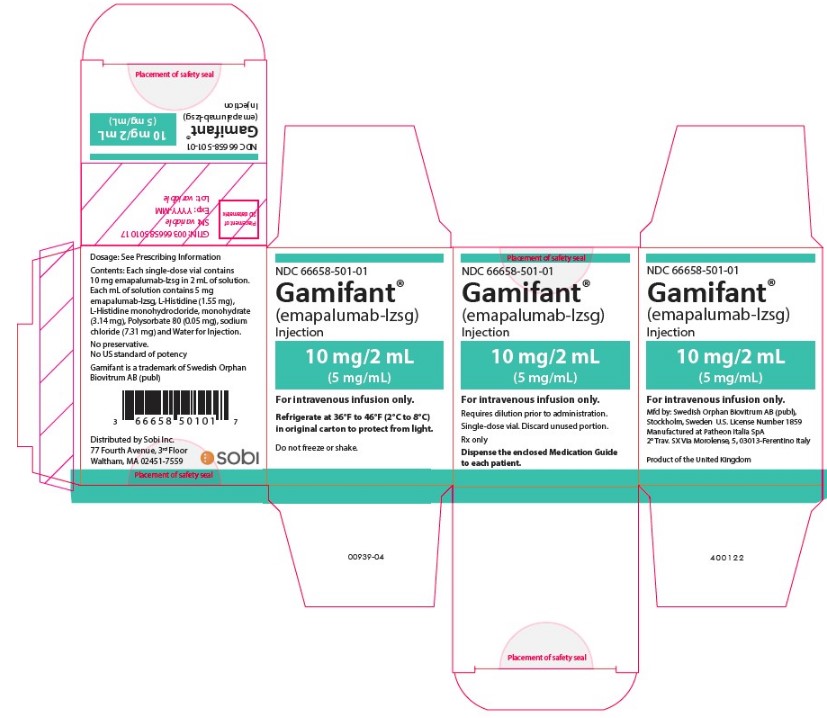
Principal Display Panel - 50 mg/10 mL Carton Label
NDC 66658-505-01
Gamifant®
(emapalumab-lzsg)
Injection
50 mg/10 mL
(5 mg/mL)
For intravenous infusion only.
Requires dilution prior to administration.
Single-dose vial. Discard unused portion.
Rx only
Dispense the enclosed Medication Guide
to each patient.
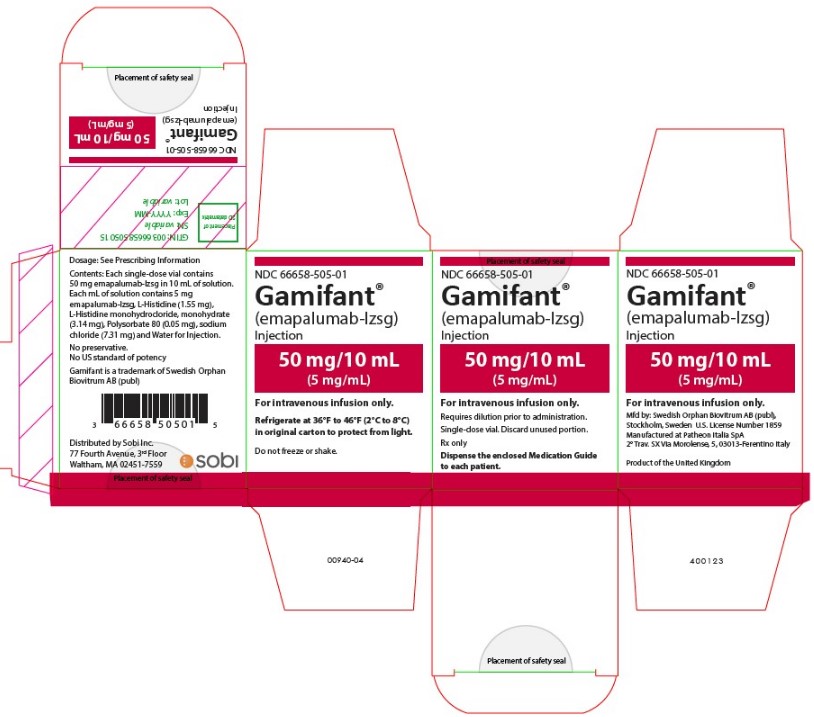
Principal Display Panel - 100 mg/20 mL Carton Label
NDC 66658-510-01
Gamifant®
(emapalumab-lzsg)
Injection
100 mg/20 mL
(5 mg/mL)
For intravenous infusion only.
Requires dilution prior to administration.
Single-dose vial. Discard unused portion.
Rx only
Dispense the enclosed Medication Guide
to each patient.
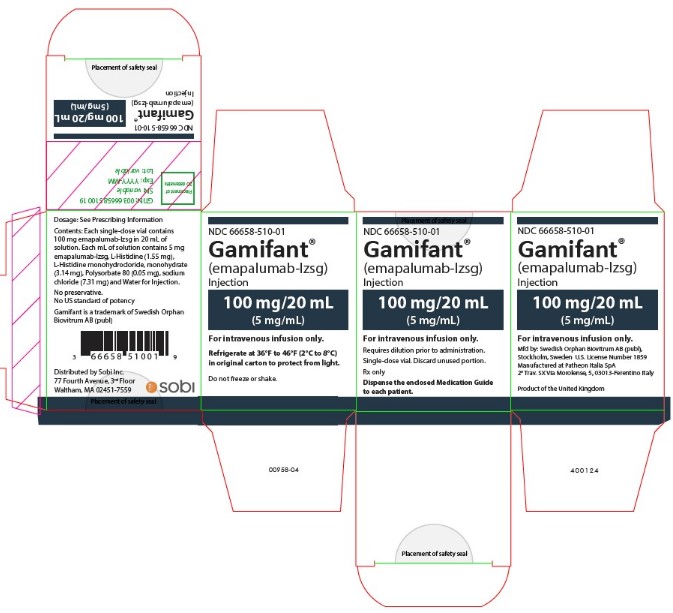
Principal Display Panel – 50 mg/2 mL Carton Label
NDC 66658-522-01
Gamifant®
(emapalumab-lzsg)
Injection
50 mg/2 mL
(25 mg/mL)
For intravenous infusion only.
Requires dilution prior to administration.
Single-dose vial. Discard unused portion.
Rx only
Dispense the enclosed Medication Guide
to each patient.
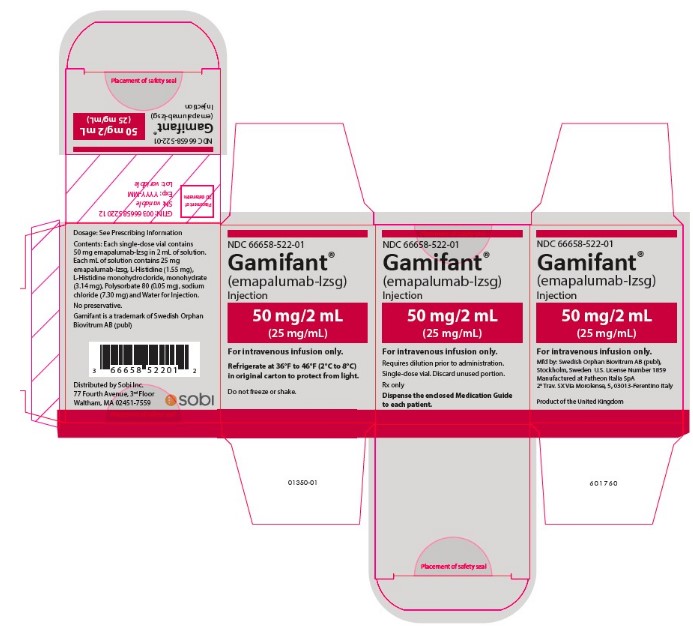
Principal Display Panel – 100 mg/4 mL Carton Label
NDC 66658-523-01
Gamifant®
(emapalumab-lzsg)
Injection
100 mg/4 mL
(25 mg/mL)
For intravenous infusion only.
Requires dilution prior to administration.
Single-dose vial. Discard unused portion.
Rx only
Dispense the enclosed Medication Guide
to each patient.
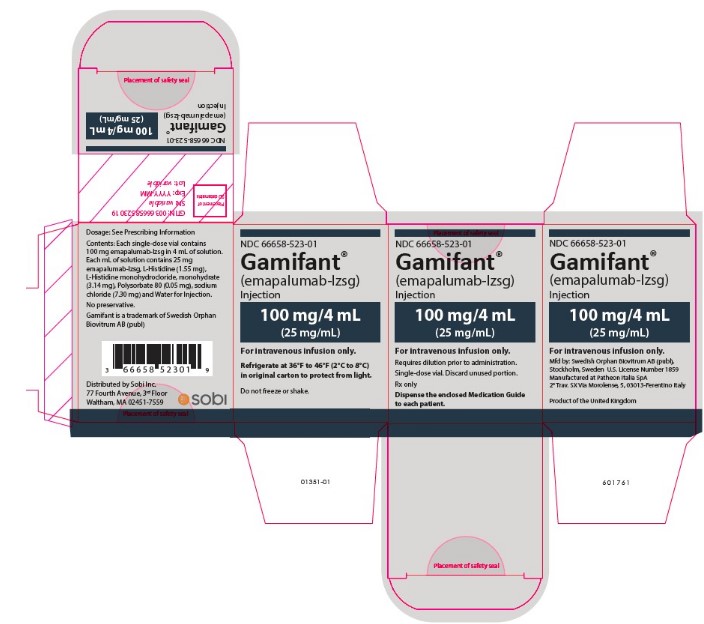
Principal Display Panel – 250 mg/10 mL Carton Label
NDC 66658-524-01
Gamifant®
(emapalumab-lzsg)
Injection
250 mg/10 mL
(25 mg/mL)
For intravenous infusion only.
Requires dilution prior to administration.
Single-dose vial. Discard unused portion.
Rx only
Dispense the enclosed Medication Guide
to each patient.
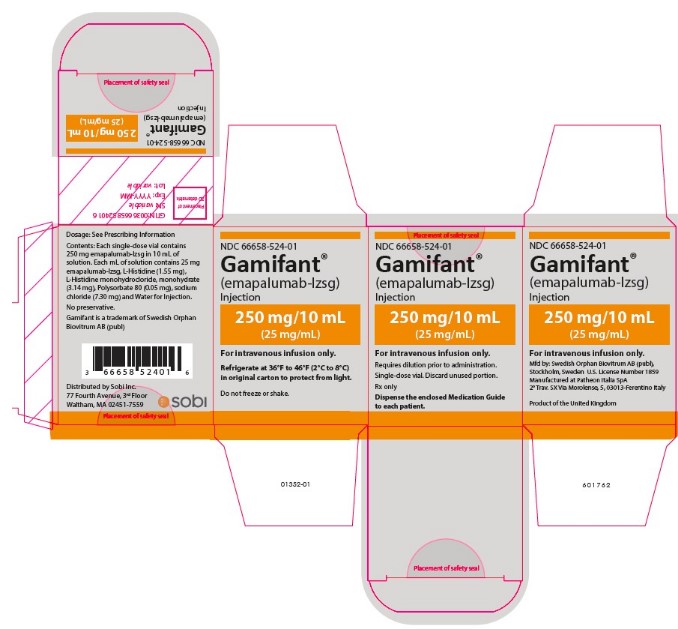
Principal Display Panel – 500 mg/20 mL Carton Label
NDC 66658-525-01
Gamifant®
(emapalumab-lzsg)
Injection
500 mg/20 mL
(25 mg/mL)
For intravenous infusion only.
Requires dilution prior to administration.
Single-dose vial. Discard unused portion.
Rx only
Dispense the enclosed Medication Guide
to each patient.
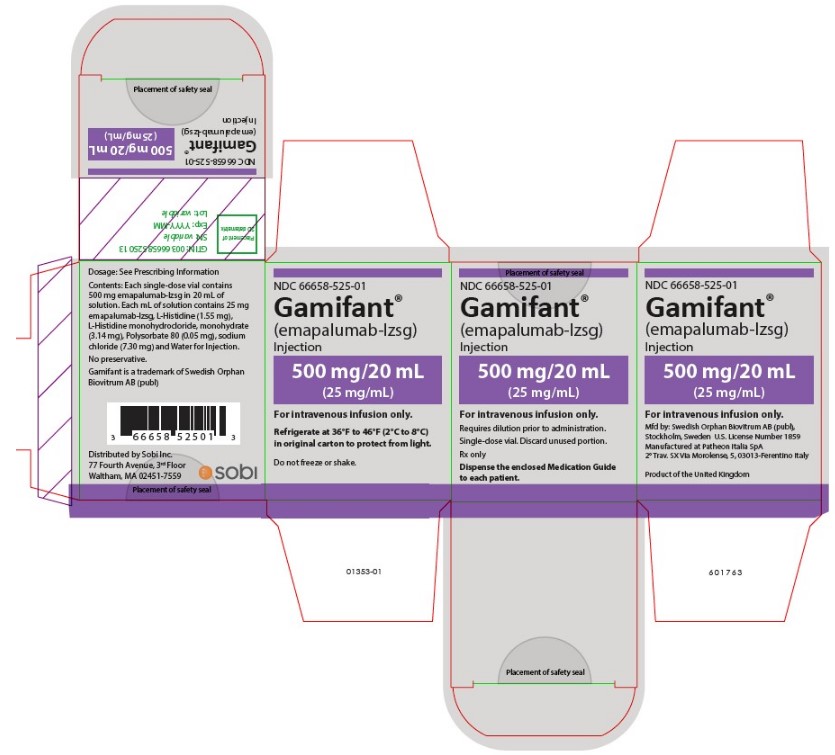
| GAMIFANT
emapalumab-lzsg injection |
||||||||||||||||||||
|
||||||||||||||||||||
|
||||||||||||||||||||
|
||||||||||||||||||||
|
||||||||||||||||||||
|
||||||||||||||||||||
| GAMIFANT
emapalumab-lzsg injection |
||||||||||||||||||||
|
||||||||||||||||||||
|
||||||||||||||||||||
|
||||||||||||||||||||
|
||||||||||||||||||||
|
||||||||||||||||||||
| GAMIFANT
emapalumab-lzsg injection |
||||||||||||||||||||
|
||||||||||||||||||||
|
||||||||||||||||||||
|
||||||||||||||||||||
|
||||||||||||||||||||
|
||||||||||||||||||||
| GAMIFANT
emapalumab-lzsg injection |
||||||||||||||||||||
|
||||||||||||||||||||
|
||||||||||||||||||||
|
||||||||||||||||||||
|
||||||||||||||||||||
|
||||||||||||||||||||
| GAMIFANT
emapalumab-lzsg injection |
||||||||||||||||||||
|
||||||||||||||||||||
|
||||||||||||||||||||
|
||||||||||||||||||||
|
||||||||||||||||||||
|
||||||||||||||||||||
| GAMIFANT
emapalumab-lzsg injection |
||||||||||||||||||||
|
||||||||||||||||||||
|
||||||||||||||||||||
|
||||||||||||||||||||
|
||||||||||||||||||||
|
||||||||||||||||||||
| GAMIFANT
emapalumab-lzsg injection |
||||||||||||||||||||
|
||||||||||||||||||||
|
||||||||||||||||||||
|
||||||||||||||||||||
|
||||||||||||||||||||
|
||||||||||||||||||||
| Labeler - Swedish Orphan Biovitrum AB (publ) (354010589) |
| Establishment | |||
| Name | Address | ID/FEI | Business Operations |
|---|---|---|---|
| Patheon Italia S.p.A | 434078638 | manufacture(66658-501, 66658-505, 66658-510, 66658-522, 66658-523, 66658-524, 66658-525) | |
| Establishment | |||
| Name | Address | ID/FEI | Business Operations |
|---|---|---|---|
| Rechon Life Science AB | 775207769 | label(66658-505, 66658-501, 66658-510, 66658-522, 66658-523, 66658-524, 66658-525) , pack(66658-501, 66658-505, 66658-510, 66658-522, 66658-523, 66658-524, 66658-525) | |
| Establishment | |||
| Name | Address | ID/FEI | Business Operations |
|---|---|---|---|
| DHL Supply Chain B.V. | 493018566 | label(66658-501, 66658-505, 66658-510, 66658-522, 66658-523, 66658-524, 66658-525) , pack(66658-501, 66658-505, 66658-510, 66658-522, 66658-523, 66658-524, 66658-525) | |
| Establishment | |||
| Name | Address | ID/FEI | Business Operations |
|---|---|---|---|
| Labcorp Early Development Laboratories | 213137276 | analysis(66658-501, 66658-505, 66658-510, 66658-522, 66658-523, 66658-524, 66658-525) | |
| Establishment | |||
| Name | Address | ID/FEI | Business Operations |
|---|---|---|---|
| Melbourn Scientific Ltd | 503337305 | analysis(66658-505, 66658-510, 66658-522, 66658-523, 66658-524, 66658-525, 66658-501) | |
| Establishment | |||
| Name | Address | ID/FEI | Business Operations |
|---|---|---|---|
| Wickham Micro Ltd | 228216353 | analysis(66658-505, 66658-510, 66658-522, 66658-523, 66658-524, 66658-525, 66658-501) | |
| Establishment | |||
| Name | Address | ID/FEI | Business Operations |
|---|---|---|---|
| Eurofins BioPharma Product Testing Munich | 313046917 | analysis(66658-501, 66658-505, 66658-510, 66658-522, 66658-523, 66658-524, 66658-525) | |
| Establishment | |||
| Name | Address | ID/FEI | Business Operations |
|---|---|---|---|
| Quality Assistance | 283676641 | analysis(66658-501, 66658-505, 66658-510, 66658-522, 66658-523, 66658-524, 66658-525) | |
| Establishment | |||
| Name | Address | ID/FEI | Business Operations |
|---|---|---|---|
| ITS Testing Services (UK) Limited | 233547491 | analysis(66658-501, 66658-505, 66658-510, 66658-522, 66658-523, 66658-524, 66658-525) | |
| Establishment | |||
| Name | Address | ID/FEI | Business Operations |
|---|---|---|---|
| Lonza AG | 480468908 | analysis(66658-501, 66658-505, 66658-510, 66658-522, 66658-523, 66658-524, 66658-525) | |
Biological Products Related to Gamifant
Find detailed information on biosimilars for this medication.
More about Gamifant (emapalumab)
- Check interactions
- Compare alternatives
- Pricing & coupons
- Drug images
- Side effects
- Dosage information
- During pregnancy
- FDA approval history
- Drug class: selective immunosuppressants
- Breastfeeding
- En español

